Hello again, dear blog. New year, new me, new engine stuff, new games, new president. Lots of new stuff, yessir. I'm pleased to announce that every major milestone in the previous post was reached. Yup, that's right, we now have:
- Camera frustum culling, for geometry, lights, and particles
- Tiled lighting, with full clustered lighting in the works
- Using UBOs in OpenGL 3.1+
- Bullet physics integration
- An ECS-ish layer for game logic
- Irradiance (GI) probes (very naive implementation)
- Parallax-corrected cubemaps, with (half-implemented) specular convolution
- An asyncronous job queue
- Instanced geometry, particles
- Dynamic mesh generation
- More built-in input controllers (for the camera)
- Slight FXAA-like antialiasing (mostly for removing specular artifacts)
- More glTF stuff, punctual lights extension
And other small fixes here and there. The engine is really starting to take shape, looking like something you might plausibly use in a modern game if you squint hard enough. Anyway, enough bullet points, here's some quick screenshots of where things are.
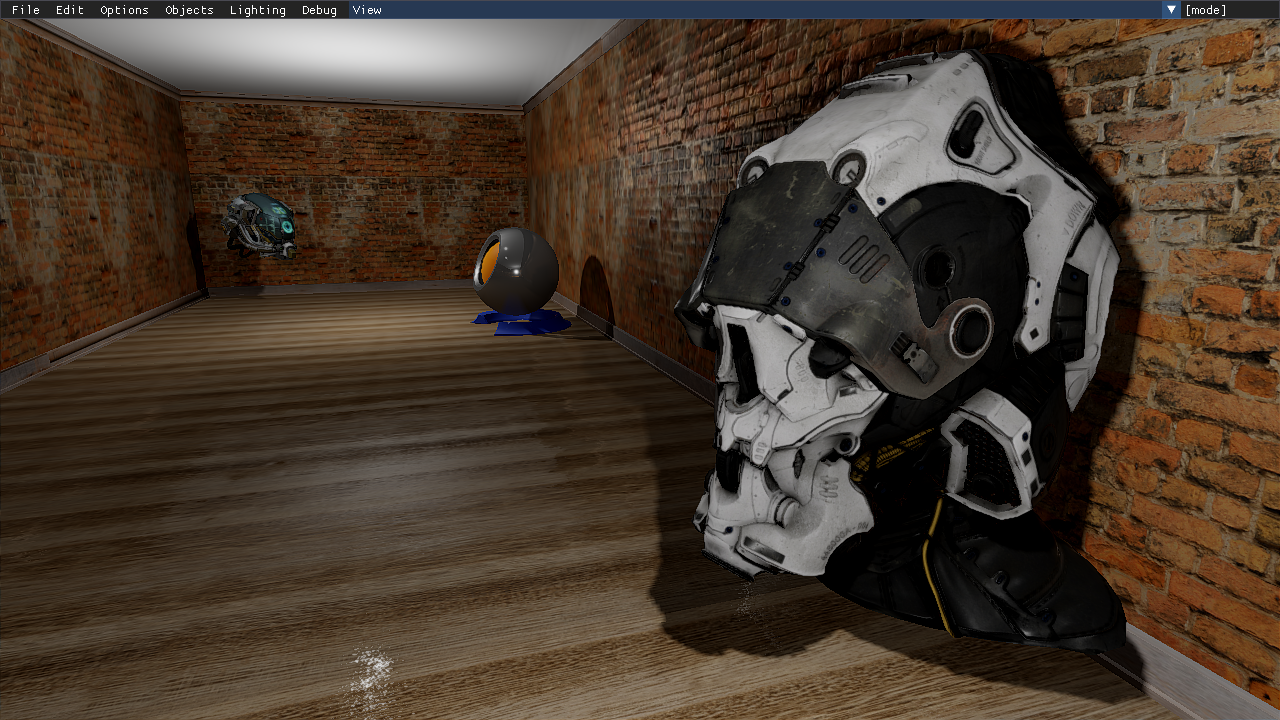
Tiled lighting
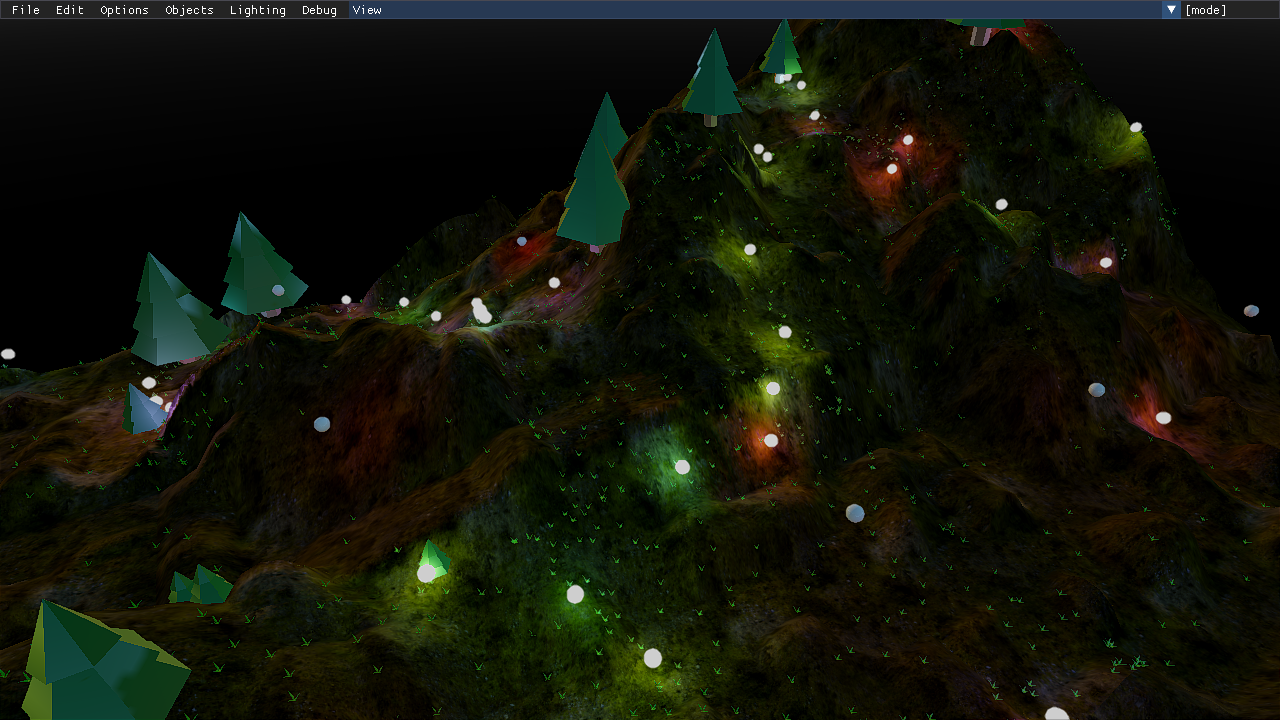
Following the ludum dare game, I had a pretty good idea of how broken my engine was, and what would be important to focus on to make it less broken. Most of the new features here are directly addressing things that I wanted to do in my game, but that I couldn't do for whatever reason. Number one was raw scene complexity, I wanted to make a much more complex ship level, with glowing lighting and cool effects, but quickly ran into problems with just about everything. I couldn't fit in more than a few lights, no geometry culling meant a hard limit on level complexity (very low on webgl), had to spend far too much time tuning the level to physics that still ended up being horribly broken, didn't have any way to organize gameplay logic, performance meant having shader effects wasn't really possible, etc etc etc.
So, I thought I'd start with the most spectacular improvement to performance and visual complexity, tiled lighting. Rather than a wimpy 8 lights on screen, it can now handle 90 point lights on-screen, with a maximum of 27 in each tile, meaning you can throw point lights basically anywhere now. This is a huge step up for effects and environment lighting, since now I can stick tiny point lights on anything of interest, enemies, health pickups, projectiles, etc. without having to worry too much about performance.
These aren't hard limits, of course, the maximum number of point lights could be increased to about 130 if point lights had a dedicated UBO, or about 500 on GPUs that allow 64KB UBOs, or practically any arbitrary number with SSBOs. But, there's not any particular reason to, tiled lighting is basically meant to be a transitory step to clustered lighting on desktop GPUs (which will require SSBOs and OpenGL 4.3+), and a performant fallback on mobile GPUs that can't handle that many point lights anyway.
Similarly to Doom 2016, generation of the tilemaps happens on the CPU. This is actually pretty fast, building the tilemaps happens after rough view frustum culling, and so the generator only has to bin lights that will affect what's on screen. This puts a very manageable bound on how many lights will need to be binned, and makes it so that the runtime increases with on-screen scene complexity rather than scene size. Overall, profiling puts the tilemap generation step at <1% total CPU time on the landscape scene here, pretty good methinks.
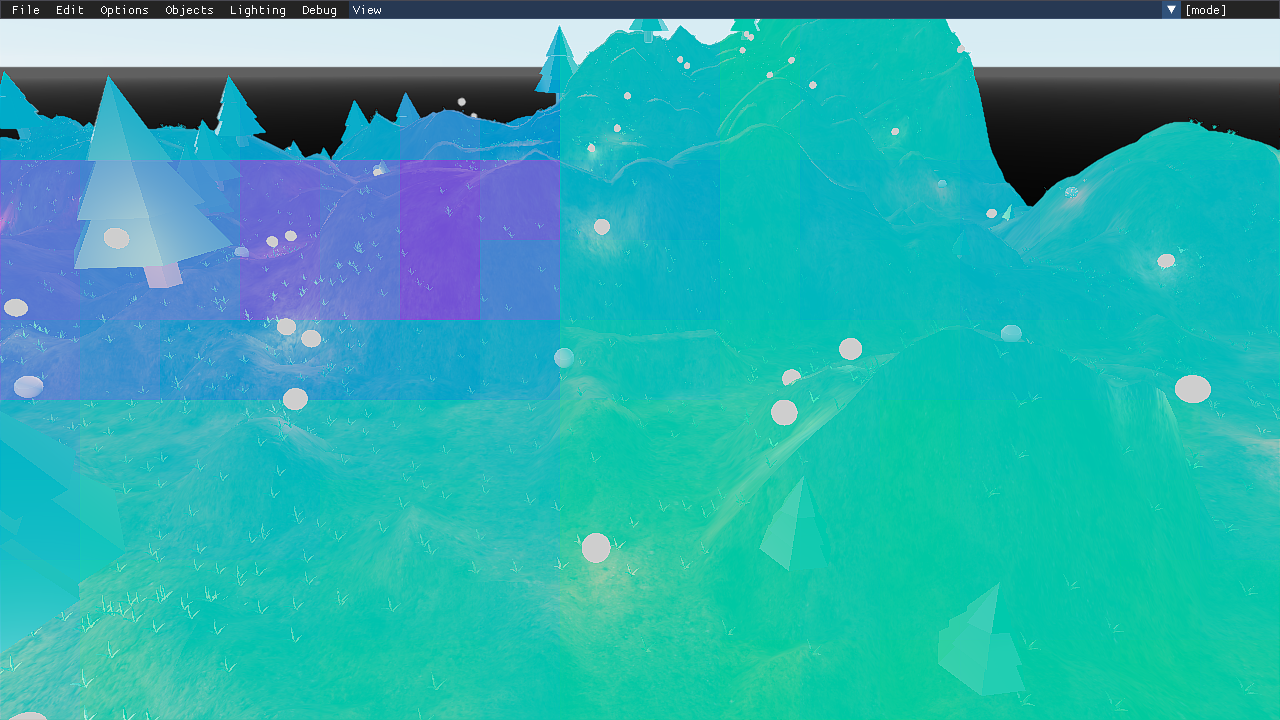
Landscape demo
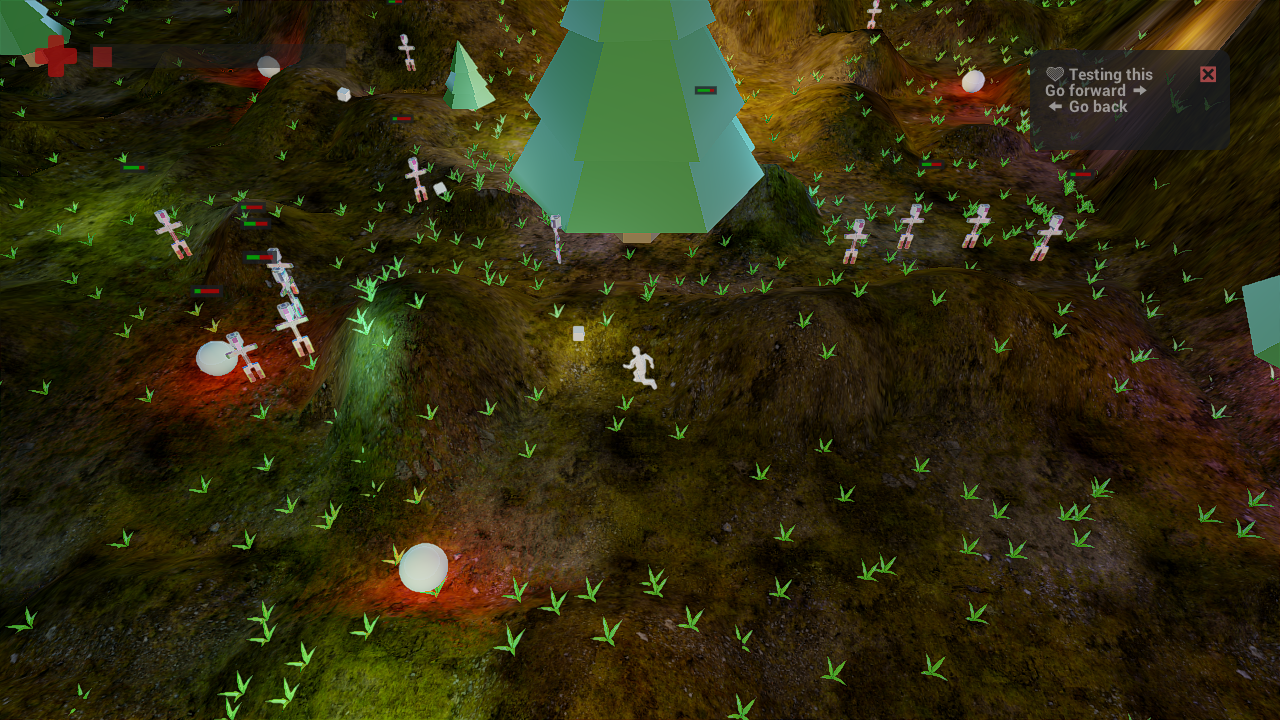
The landscape generator has kind of become my testbed for everything, it uses pretty much every new feature added. Asyncronous generation for landscape meshes, bullet physics for collision, lots of random point lights, instanced landscape props, and ECS logic for entities on the map. Unlike the lighting stuff this doesn't lend itself as well to pictures, but the video here should give a good idea of what was added.
Visually, it needs a lot of work still, like the texture stretching on the landscape, or the blocky CC0 placeholder trees. One thing I'm really interested in doing is procedurally-generated vegetation with L-systems, so that might be something for the next post.
Entity-Component-System system
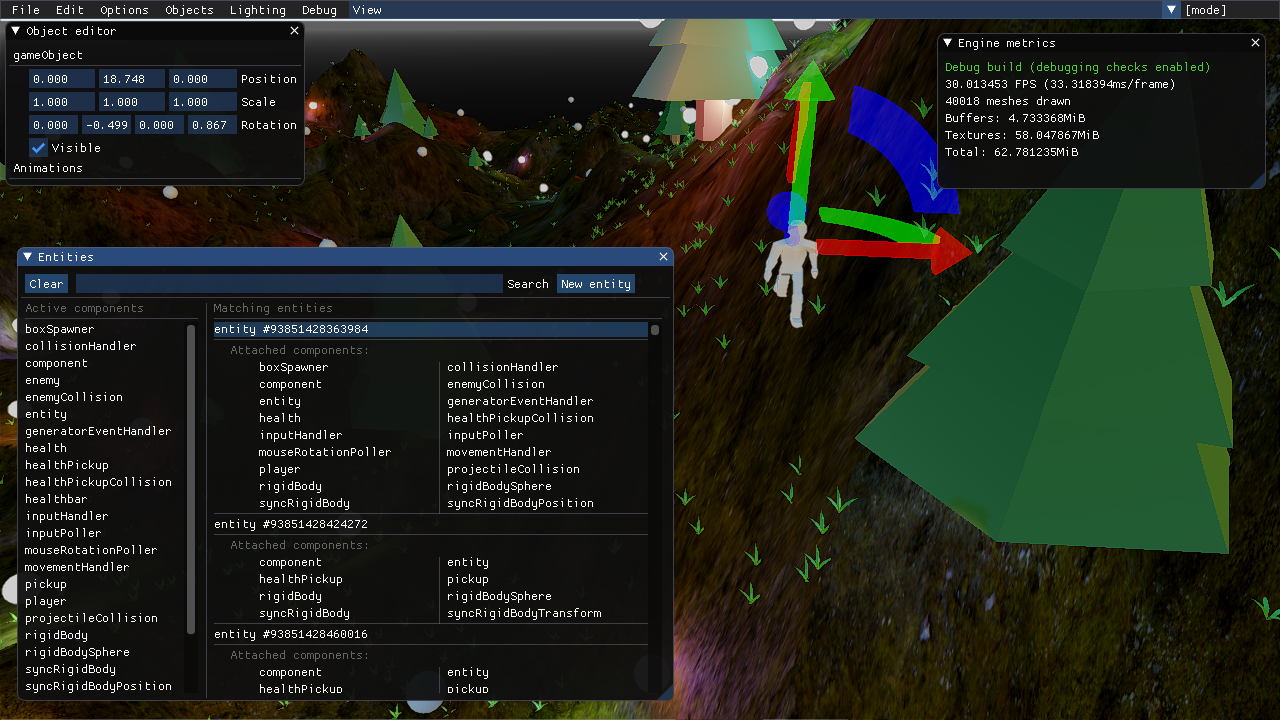
The hottest new thing in game programming, of course. Attach anything to
anything! Turn your code into
a nest of if (thing != nullptr){ ... }
;-)! For real though, I've been skeptical of ECS for a while, the code for
the unity ECS always looks pretty gnarly, but when it comes down to it there's
probably not a better way to organize game logic. By nature it's something
that has a lot of complex interaction and edge cases, no way around it. So,
I've decided to roll my own ECS, and the design I've settled on is sort of a hybrid
between the regular c++-style inheritance-based class system, and the ID-based
style used in other ECSs. Entities and components are pointers to base
entity/component objects, which you can dynamic_cast to their
derived types, and which can contain game logic. Components are indexed in
the entity manager, so you can query for entities that match any set of
attached components, sort of like a relational DB.
Systems then use that query system to get the entities that they work on, so
you can define systems that work on any arbitrary combination of components.
Overall from the small amount of programming I've done with it, it seems ok so far. I doubt there will be any sweeping changes that will need to be made, definitely lots of improvements though.
Here's a quick sample of the health pickup component, which illustrates sort of what the average component looks like:
class healthPickupCollision : public collisionHandler {
float damage;
float lastCollision = 0;
public:
healthPickupCollision(entityManager *manager, entity *ent,
float _damage = 2.5f)
: collisionHandler(manager, ent, {"healthPickup"})
{
damage = _damage;
manager->registerComponent(ent, "healthPickupCollision", this);
}
virtual void
onCollision(entityManager *manager, entity *ent,
entity *other, collision& col)
{
std::cerr << "health pickup collision!" << std::endl;
healthPickup *pickup = dynamic_cast<healthPickup*>(other);
if (pickup) {
pickup->apply(manager, ent);
manager->remove(pickup);
}
};
};
As you might guess from the name, this component adds logic for handling
collisions with health pickups. This makes specifying what can pick up
health as simple as adding this component, which handles all the details.
There's a collision system in the background that looks for
collisionHandler components, which then calls this
onCollision() here when there's an entity collision matching the
{"healthPickup"} set given. Pretty snazzy eh? Starting to
get real OOP here.
Fin.
Aaaand that's all for now. Things that I'm planning to work on next include better art, triplanar filtering and texture blending for the landscape, a proper resource manager with async loading, putting the octree code to work for some voxel-based destruction, procedural vegetation, and that sort of thing. Clustered lighting is in the future but not urgent, it would be pretty simple to add on the existing codebase (just need to add Z planes.) Beyond that, I'm looking at using a scripting language for abstracting away some of the more repetitive parts of entity/component programming, and writing/pulling in a framework to do nicer shader preprocessing than my rat's nest of macros.